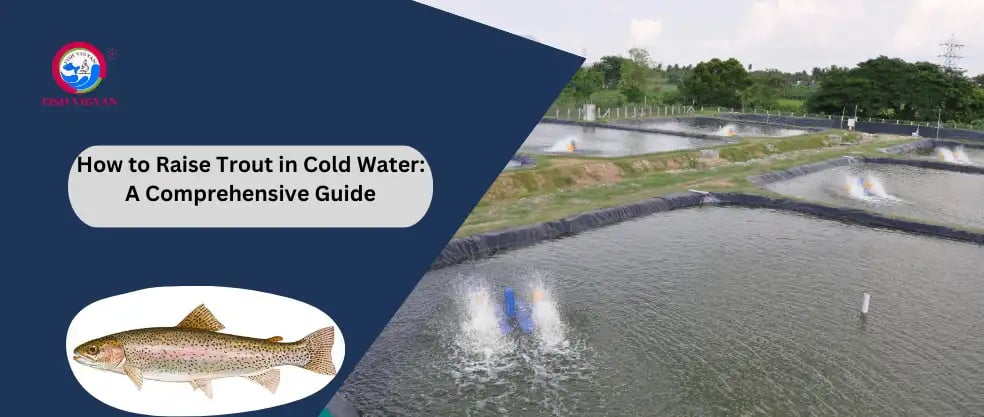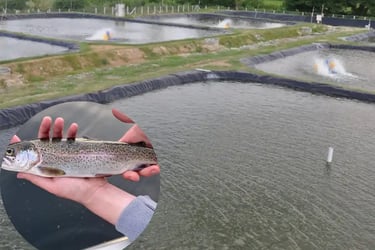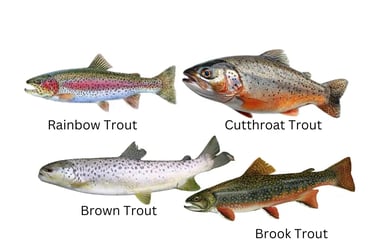How to Raise Trout in Cold Water: A Comprehensive Guide
Raising trout in cold water is rewarding for hobbyists and commercial farmers. These hardy, fast-growing fish thrive in clean, cold environments, making them ideal for aquaculture. This guide covers essential steps, from species selection to harvesting, for a successful trout farming operation.


How to Raise Trout in Cold Water: A Comprehensive Guide
Raising trout in cold water is a rewarding and enjoyable endeavor that appeals to both hobbyists and commercial fish farmers. Trout are hardy, fast-growing fish that thrive in cold, clean water, making them an excellent choice for aquaculture. Whether you’re raising trout for personal consumption, recreational fishing, or commercial purposes, understanding the intricacies of trout farming is essential for success. This guide will walk you through every step of the process, from selecting the right species to harvesting your fish, ensuring you have the knowledge and tools to create a thriving trout-raising operation.


Understanding Trout Species
Before diving into trout farming, it’s important to familiarize yourself with the different species of trout. Each species has unique characteristics, growth rates, and environmental preferences. The most common trout species raised in cold water include:


1. Rainbow Trout (Oncorhynchus mykiss):
Rainbow trout are the most popular choice for aquaculture due to their adaptability, rapid growth, and vibrant colors. They thrive in water temperatures between 50°F and 65°F (10°C to 18°C) and are known for their resilience in various environments. Rainbow trout are also highly sought after for their delicious flavor, making them a favorite among chefs and consumers.
2. Brown Trout (Salmo trutta):
Brown trout are hardy and can tolerate slightly warmer water temperatures compared to other trout species. They are often preferred for recreational fishing due to their size and fighting spirit. Brown trout are also known for their longevity, with some individuals living up to 20 years in the wild. They are more territorial than rainbow trout, so they require more space in a farming environment.
3. Brook Trout (Salvelinus fontinalis):
Brook trout, also known as speckled trout, are smaller and prefer colder, pristine water. They are native to North America and are often found in streams and lakes with high oxygen levels. Brook trout are highly sensitive to water quality, making them a good indicator species for environmental health. They are also prized for their delicate flavor and beautiful coloration.
4. Cutthroat Trout (Oncorhynchus clarkii):
Cutthroat trout are native to the western United States and are known for the distinctive red or orange slash marks under their jaws. They prefer cold, clear streams and are often found in high-altitude environments. Cutthroat trout are less commonly raised in aquaculture due to their specific habitat requirements, but they are a popular choice for conservation projects and recreational fishing.
Choosing the right species depends on your goals, local climate, and available resources. For beginners, rainbow trout are often the best choice due to their adaptability and ease of care. However, if you’re looking for a challenge or have specific environmental conditions, brown or brook trout may be more suitable.
Ideal Water Conditions for Trout
Trout are cold-water fish, meaning they require specific environmental conditions to thrive. Here are the key factors to consider when setting up your trout habitat:
1. Water Temperature
Trout thrive in water temperatures between 50°F and 65°F (10°C to 18°C). Temperatures above 70°F (21°C) can stress the fish, reduce their appetite, and increase susceptibility to diseases. Use a reliable thermometer to monitor water temperature regularly. In warmer climates, consider using shade structures, chillers, or groundwater sources to maintain optimal conditions. It’s also important to note that sudden temperature fluctuations can be harmful, so aim for a stable environment.
2. Oxygen Levels
Trout require high levels of dissolved oxygen to survive. Aim for oxygen levels of at least 6 mg/L. To maintain adequate oxygen levels:
Use aerators, air stones, or fountains to increase water movement and oxygenation.
Avoid overcrowding, as too many fish can deplete oxygen levels quickly.
In ponds, consider adding aquatic plants like water lilies or duckweed, which can help oxygenate the water during the day.
3. PH Levels
The ideal pH range for trout is between 6.5 and 8.5. Regularly test the water using a pH kit and adjust as needed. Natural methods like adding crushed limestone or baking soda can help stabilize pH levels. Avoid drastic pH changes, as they can stress the fish and disrupt their biological processes.
4. Water Quality
Trout are sensitive to poor water quality, so regular monitoring is essential. Test for ammonia, nitrite, and nitrate levels, as high concentrations can be toxic. Perform partial water changes (10-20% weekly) to maintain a clean environment. A good filtration system is also crucial for removing waste and maintaining water clarity. Additionally, avoid using chemicals or pesticides near your trout habitat, as they can contaminate the water and harm the fish.
Setting Up Your Trout Habitat
Creating a suitable habitat is critical for the health and growth of your trout. Whether you’re using a tank, pond, or raceway, follow these steps to set up your trout-raising environment:
1. Choosing the Right Location
Select a location that provides natural shade and protection from direct sunlight. If you’re using a pond, ensure it has a reliable water source, such as a spring or stream, to maintain consistent water levels and quality. The location should also be free from pollutants and have good drainage to prevent flooding.
2. Tank or Pond Size
The size of your habitat depends on the number of trout you plan to raise. A general rule is to provide at least 1 square foot of space per fish. For larger operations, a pond with a capacity of 1,000 gallons or more is recommended. If you’re using a tank, ensure it’s made of durable materials like fiberglass or food-grade plastic.
3. Filtration System
Invest in a high-quality filtration system to keep the water clean and free of harmful toxins. A combination of mechanical, biological, and chemical filtration is ideal for maintaining optimal water quality. Mechanical filters remove debris, biological filters break down waste, and chemical filters remove harmful substances like ammonia and nitrites.
4. Adding Substrate and Plants
Adding gravel or sand to the bottom of your tank or pond can create a natural habitat for your trout. Aquatic plants like watercress or duckweed can provide shelter, improve water quality, and serve as a supplemental food source. Plants also help oxygenate the water and provide a more natural environment for the fish.
Feeding Your Trout
Proper nutrition is essential for the growth and health of your trout. Here’s how to ensure your fish receive a balanced diet:
1. Choosing the Right Feed
High-quality commercial trout feed is the most convenient and effective option. Look for feeds that contain:
40-50% protein for optimal growth.
10-15% fat for energy.
Essential vitamins and minerals for overall health.
You can also supplement their diet with live food like worms, insects, or small crustaceans for added nutrition. Live food not only provides variety but also stimulates natural hunting behaviors.
2. Feeding Schedule
Feed your trout 2-3 times daily, offering only what they can consume in 10-15 minutes. Overfeeding can lead to water quality issues and health problems. Adjust the feeding schedule based on the age and size of your trout. Younger fish require more frequent feedings, while adult trout can be fed less often.
3. Monitoring Growth
Regularly measure and weigh your trout to track their growth. Adjust their diet or feeding frequency if growth rates are slower than expected. Keep a record of their growth to identify trends and make informed decisions about their care.
Health Management
Maintaining the health of your trout is crucial for a successful operation. Here are some tips for preventing and managing diseases:
1. Regular Health Checks
Inspect your trout daily for signs of illness, such as lethargy, abnormal swimming, or changes in appetite. Early detection is key to preventing the spread of disease. Look for physical signs like lesions, discoloration, or fin rot, which can indicate underlying health issues.
2. Disease Prevention
Quarantine new fish for at least two weeks before introducing them to your main habitat.
Maintain optimal water quality to reduce stress and prevent disease outbreaks.
Consider vaccinating your trout if you’re raising them commercially. Vaccines are available for common diseases like furunculosis and vibriosis.
3. Treatment Options
If you notice signs of illness, consult a veterinarian or aquaculture specialist. Common treatments include medicated feeds, salt baths, or water treatments. Always follow the recommended dosage and treatment duration to avoid harming your fish.
Harvesting Your Trout
Harvesting is the final step in your trout-raising journey. Here’s how to do it effectively:
1. Timing
Most trout reach a harvestable size of 1-2 pounds within 12-18 months, depending on the species and conditions. Monitor their growth regularly to determine the best time for harvesting.
2. Harvesting Techniques
Use a net or fish trap to catch your trout. Handle them gently to minimize stress and injury. If you plan to sell your trout, keep them in a clean, aerated container during transport. For larger operations, consider using a fish pump or grader to streamline the harvesting process.
3. Processing
If you’re harvesting for personal consumption, clean and gut the fish immediately after catching. Store them on ice or in a refrigerator to maintain freshness. For commercial operations, follow proper processing and packaging guidelines to ensure product quality.
Additional Tips for Success
Record Keeping
Maintain detailed records of water quality, feeding schedules, growth rates, and health checks. This information will help you identify trends, troubleshoot issues, and improve your trout-raising practices over time.Biosecurity Measures
Implement biosecurity measures to prevent the introduction of diseases. This includes disinfecting equipment, limiting visitor access, and avoiding the use of shared water sources.Sustainability Practices
Consider adopting sustainable practices like using renewable energy sources, recycling water, and minimizing waste. These efforts not only benefit the environment but can also reduce operating costs in the long run.Community Engagement
If you’re raising trout commercially, consider engaging with your local community. Offer tours, host educational workshops, or sell your trout at farmers’ markets. Building a strong connection with your community can enhance your business’s reputation and customer base.
Conclusion
Raising trout in cold water is a fulfilling and potentially profitable venture that requires careful planning and dedication. By understanding the specific needs of trout, creating an optimal habitat, providing proper nutrition, and managing their health, you can ensure the success of your trout-raising operation. Whether you’re a hobbyist or a commercial farmer, the rewards of raising healthy, vibrant trout are well worth the effort. With patience and attention to detail, you’ll be well on your way to becoming a successful trout farmer. Happy trout raising!
